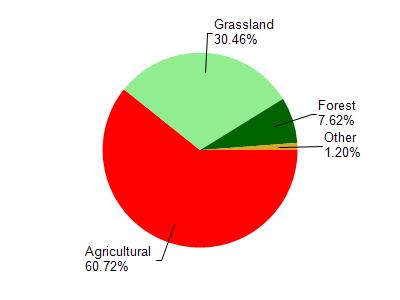Lafayette
No
No
No
Fish and Aquatic Life
Overview
This spring fed and warm water drainage stream flows northeastward and joins the Pecatonica River near the village of Gratiot. Smallmouth bass, walleye and channel catfish have been found in the lower section (Surface Waters of Lafayette County, 1967). More recently, the entire length of the stream is managed as a Class II trout fishery (Wisconsin Trout Streams, 2002). It has not been monitored in recent years.
Date 2002
Author Aquatic Biologist
Historical Description
As a spring-fed and warm water drainage stream, Wolf Creek flows northeasterly into the West Branch of the Pecatonica River. There are four unnamed tributaries that have a perennial flow. Their combined discharges are equivalent to about 30 percent of Wolf Creek's total discharge. Trout Brook (Slawther Creek) is a principal tributary which enters just above the mouth at the town of Gratiot. Its flow contributes about 46 percent of Wolf Creek's base flow. Most of tile floodplain throughout the watershed is in firm and meadow pasture while the uplands are either cropped or heavily wooded. Rubble mixed with gravel is the most common bottom type while silt is found at the mouth. The sport fishery consists of a large population of smallmouth bass with some walleyes and channel catfish in lower reaches. Upland game species found in the watershed are pheasants, Hungarian partridge, quail, deer, squirrels and rabbits. Aquatic game consists of some waterfowl in the spring and fall. Muskrats are common near the mouth. Access can be had from five road crossings. There are no public lands in tile watershed.
Wolf Creek, T1N, R4E, Sections 4-16, Surface acres = 13.8, Miles = 9.7, Gradient = 21.6 feet per mile, Total alkalinity = 316 mg/l, Volume of flow = 8.7 cfs.
From: Piening, Ronald; Poff, Ronald; Threinen, C.W., 1967. Lake and Stream Classification Project. Surface Water Resources of Lafayette County, Wisconsin Department of Natural Resources, Madison, WI.
Date 1967
Author Aquatic Biologist
General Condition
Wolf Creek (miles 3.15-8.29) was assessed during the 2018 listing cycle; new biological (fish Index of Biotic Integrity (IBI) scores) sample data were clearly below the 2018 WisCALM listing thresholds for the Fish and Aquatic Life use. This water was meeting this designated use and was not considered impaired.
Date 2017
Author Ashley Beranek
Condition
Wisconsin has over 84,000 miles of streams, 15,000 lakes and milllions of acres of wetlands. Assessing the condition of this vast amount of water is challenging. The state's water monitoring program uses a media-based, cross-program approach to analyze water condition. An updated monitoring strategy (2015-2020) is now available. Compliance with Clean Water Act fishable, swimmable standards are located in the Executive Summary of Water Condition in 2018. See also the 'monitoring and projects' tab.
Reports
Management Goals
Wisconsin's Water Quality Standards provide qualitative and quantitative goals for waters that are protective of Fishable, Swimmable conditions [Learn more]. Waters that do not meet water quality standards are considered impaired and restoration actions are planned and carried out until the water is once again fishable and swimmable
Management goals can include creation or implementation of a Total Maximum Daily Load analysis, a Nine Key Element Plan, or other restoration work, education and outreach and more. If specific recommendations exist for this water, they will be displayed below online.
Monitoring
Monitoring the condition of a river, stream, or lake includes gathering physical, chemical, biological, and habitat data. Comprehensive studies often gather all these parameters in great detail, while lighter assessment events will involve sampling physical, chemical and biological data such as macroinvertebrates. Aquatic macroinvertebrates and fish communities integrate watershed or catchment condition, providing great insight into overall ecosystem health. Chemical and habitat parameters tell researchers more about human induced problems including contaminated runoff, point source dischargers, or habitat issues that foster or limit the potential of aquatic communities to thrive in a given area. Wisconsin's Water Monitoring Strategy was recenty updated.
Grants and Management Projects
Monitoring Projects
| WBIC | Official Waterbody Name | Station ID | Station Name | Earliest Fieldwork Date | Latest Fieldwork Date | View Station | View Data |
|---|
| 918000 | Wolf Creek | 333045 | Wolf Creek at Sth 11 Gratiot | 5/7/1975 | 12/4/1975 | Map | Data |
| 918000 | Wolf Creek | 10032524 | Wolf Creek at Hwy. 11 Gratiot | 6/6/2012 | 1/1/2015 | Map | Data |
| 918000 | Wolf Creek | 333047 | Wolf Creek - Below Gratiot Stp | 5/7/1975 | 12/4/1975 | Map | Data |
| 918000 | Wolf Creek | 10031835 | Wolf Creek at ATV Trail Bridge | 1/1/2015 | 1/1/2015 | Map | Data |
| 918000 | Wolf Creek | 10014315 | Wolf Creek Lower | | | Map | Data |
| 918000 | Wolf Creek | 10014314 | Wolf Creek Upper Above Confluence With Trout Brook | | | Map | Data |
|

Watershed Characteristics
Wolf Creek is located in the Lower Pecatonica River watershed which is 134.23 mi². Land use in the watershed is primarily agricultural (60.60%), grassland (30.40%) and a mix of forest (7.60%) and other uses (1.20%). This watershed has 333.90 stream miles, 40.87 lake acres and 274.90 wetland acres.
Nonpoint Source Characteristics
This watershed is ranked Not Ranked for runoff impacts on streams, Not Ranked for runoff impacts on lakes and High for runoff impacts on groundwater and therefore has an overall rank of High. This value can be used in ranking the watershed or individual waterbodies for grant funding under state and county programs.However, all waters are affected by diffuse pollutant sources regardless of initial water quality. Applications for specific runoff projects under state or county grant programs may be pursued. For more information, go to surface water program grants.